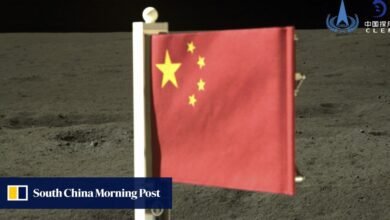Sinkhole Science in the Sanctuary | News, sports, jobs


News photo by Darby Hinkley Cecilia Howard, left, and Diana Velazquez, both Ph.D. candidates in the Department of Earth and Environmental Sciences at the University of Michigan, stand next to the sediment trap they just cleaned after it was removal of the Middle Island sinkhole.
ALPENA — Sinkhole science is happening at Thunder Bay National Marine Sanctuary, and two researchers are collecting samples from the bottom of underwater sinkholes to be analyzed at the University of Michigan lab.
Cecilia Howard and Diana Velazquez are both Ph.D. candidates in the Department of Earth and Environmental Sciences at the University of Michigan. They conducted a similar survey last year in Thunder Bay and returned last week to collect more samples.
“We recovered this yesterday,” Howard said Tuesday of the sediment trap, a large yellow funnel-shaped piece of equipment. “It was implemented during the winter. We redeployed it in October and are now cleaning it up. This is a sediment trap, which collects particulate matter that’s falling into the water column and channels it into a bunch of bottles, and on a schedule we’ll rotate the bottles, so you can get samples that have been collected throughout this period of time.”
These samples will then be analyzed in the U-of-M laboratory to determine any changes or new discoveries about the sediment.
“We are really interested in how low-oxygen conditions in the Middle Island Sinkhole impact the nutrient cycling of essential elements like carbon and nitrogen,” said Velazquez. “So we’re basically tracking what are the sources that get into the sediments and are ultimately preserved in the Middle Island sinkhole.”
She continued: “The sinkhole is full of microbial mats, mainly composed of cyanobacteria.”
“Lots of proteobacteria, too,” Howard added. “One of the things I’m looking at, actually, is what’s happening with these microbial communities. The microbial mats on the surface are really distinctive and look super cool. They are kind of purple and white and sometimes form little gaseous fingers that stick out from the sediments. But there are also superdiverse communities in the sediments. So one of the things I’m looking at in the sinkhole is: how are these communities changing over time? Because we’ve been sampling here for several years at this point.”
Howard said others took samples before doing the latest fieldwork and research.
“One of the things I’m looking at is actually how are these microbial communities being affected by, for example, changes in the ice cover and the temperature of the lake above?” Howard said. “Because the material that falls ends up in the sediment, so this changes from year to year.”
“We also obtained some sediments from Lake Huron, which would be in the oxygenated region of the lake, for a form of comparison,” Velázquez said, adding that these samples will also be analyzed. “We want to compare not only how conditions in the Middle Island Sinkhole are changing over time, but also in Lake Huron in general.”
Howard explained the purpose of this research.
“One aspect of this is that, as we’ve been sampling here for a long time, anoxic sediments are generally considered to preserve climate signals and signs of life very well, because things don’t decompose very well when there’s no oxygen, because a lot of the organisms that might be eating all that organic matter can’t live there because there’s no oxygen,” Howard said. “Looking at the Middle Island Sinkhole, as we have this sampling year after year, we can see how things are changing and how that is being influenced by the lake as a whole. It is potentially better preserved than where there is oxygen and where there are worms and shellfish mixing up the sediments much more. So you can see how these climate and environmental signals are changing over time.”
Howard added: “We have pretty consistent sediment samples since about 2012.”
Stephanie Gandulla, resource protection coordinator at Thunder Bay National Marine Sanctuary, spoke about the importance of this research being done in the Sanctuary.
“The Sanctuary is always excited to facilitate different types of science here on Lake Huron,” Gandulla said. “Scientists from around the world have been attracted to the unique environment of the Middle Island Sinkhole since the Sanctuary designation. What the work of Cecelia, Diana and their colleagues is doing is really putting Alpena and the Sanctuary on the map as a place to do cutting-edge science.”
Darby Hinkley is the editor of Lifestyles. She can be reached at 989-358-5691 or dinkley@thealpenanews.com.




